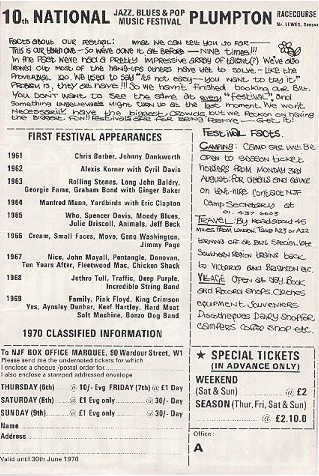
Streat. East Sussex.
6th-9th Aug 1970.
The Archive.
updated June 2021
 |
Streat. East Sussex. 6th-9th Aug 1970. |
|
The National Jazz and Blues Festivals of the middle to late sixties were important musical events because they showcased the best of the British rock, jazz and pop bands of the time. Many bands got their big breaks at these festivals, if you performed well, receiving audience acclaim could lead to residencies at the prestigious Marquee club . Some artists even got recording contracts out of their appearances . However,
by this time, the National Jazz and
Blues Festival fortunes were beginning to wane. It could
no longer be said to be the most prestigious , or largest Festival in
the UK summer calendar . In 1970 there was massive competition for the
festival punters pound from the mega festivals at Bath
and the Isle Of Wight .
The international line-up of both these giants dwarfed the line-up of
UK bands that the National Jazz Federation
promoters had signed up and consequently there was a fairly
low turn out for this festival . Barely 12,000 for the Friday concert
, although I don't know the exact figures for the entire festival.
|
Van Der Graaf Generator onstage - photo courtesy Sean Kelly |
To some extent , this led to a change in direction . Future festivals abandoned any pretence of being jazz or folk orientated and in some ways the move to Reading the next year was symbolic of the changes that went down in the Nat Jazz and Blues booking policy.
Although
the festival was marketed as a Blues mecca, there are none of the overseas
imports which were sprinkled amongst the earlier bashes , in fact there hadn't
been an overseas artist of note since 1967, when Zoot
Sims and Yusef Lateef had been the jazz
stars of the weekend. Overall in fact this festival line-up was comprised of
middle of the road bands and was nowhere near as strong as the 1969 line-up,
which had boasted Pink Floyd and King Crimson. There was also a lot less competition
in 69. In 1970, Hollywood , Bath,
Phun City and the Isle Of
Wight were all held within weeks of Plumpton and most of them had
much bigger artists on show.

|
|
Yes played at around 7.30 on the Sunday in chilly but clear weather and people took the wooden chairs from the press area and made a bonfire about 30 yards back from the stage. Jon Andersen was in great voice and the evening turned into one of those glad to be alive experiences. Andrew Harris Right: Yes ,onstage Plumpton 1970 |
|
|
 |
 |
|
I was 15 then and staying in Eastbourne UK as a summer school student.
Our teacher taught us English with song records from the "top of the pops" and their printed lyrics. I was brought there by a german friend telling me we were going to see "bands"
It was a tremendous encounter with the rock scene for me, since I was only able to listen to recordings on radio and vinyl records. (Who came to Israel to give concerts in the late 60's and early 70's?) I was mostly impressed by John Hiseman - Colosseum -, all the crowd stood up and applauded his 14 minute solo. I bought their records from then on.
Deep Purple Gave their "Black Night" in premiere then and as usual, put one or two speakers on fire; It was better indeed than just listening to these giants.
I must say that after this festival I missed a few more class days because we went on to the Isle of Wight festival one or two weeks later... (to see the last of Jimmy Hendrix)
Two years later I was working as a DJ in the school discotheque.
Albert.
Haifa Israel
Re the seats at the 1970 festival, we were at the very front of the non-seated area... the seats were presumably for press and VIP's, but Hell's Angels had moved in by late afternoon. Good concert though, highlighted by Deep Purple setting fire to the stage back-cloth (presumably planned).
All the best,
Rod JonesThe Festival was gradually becoming more insular and less eclectic in its choice of acts. Progressive , Heavy and Blues Rock based acts were becoming the order of the day and the classic blues and jazz element was on the way out. Folk/rock acts were still present, but these would gradually fade in the next years too. As always the festival had mirrored the changes in popular music , it had to do so , or lose money, but it was sad to see the wider mix of music disappear , as it was something that made the festival unique in the British music scene.
The early festivals.
You can find out the complete
line ups of the first festivals if you follow the links below.
|
|
|
|
|
Festivals 65-83
Most of these have fairly complete documentation .
| |
|
|
|
|
| |
|
|
|
|